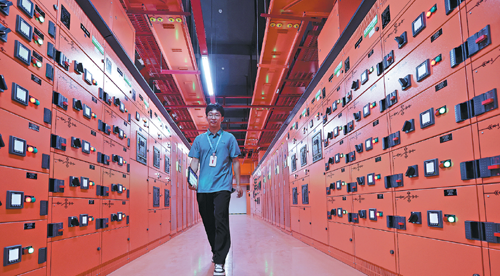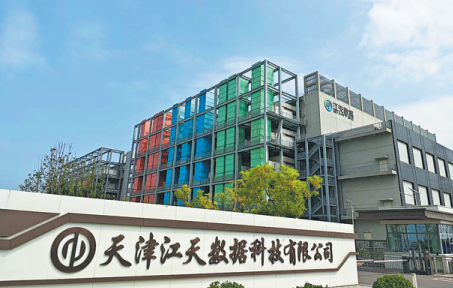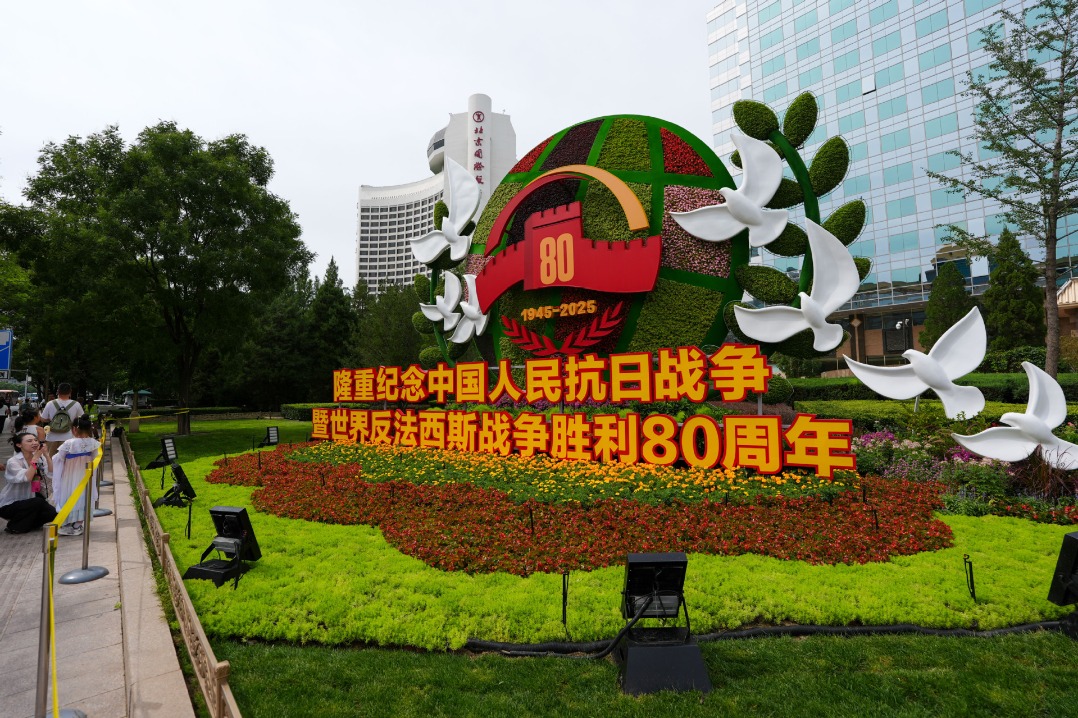Tianjin data center's steel will to save energy
Steelmaker transforms itself from heavy industry workhorse to digital dynamo

Despite making the extraordinary decision to pivot from being a heavy industry player to a digital industry heavyweight in 2017, Tianjin GiantDC Technology Co, located in Tianjin's Beichen district, has been able to carry over parallels from these two seemingly diametrically opposed businesses.
Taking the leap from making steel to storing data was not as crazy as it sounds in the context of China's large-scale push to move away from polluting heavy industries and the promotion of the digital economy, as demonstrated by the national dual carbon goals and Digital China strategy.
"Saving energy was the key to survival for steel companies. Today, the concept of energy management has become a key part of our way of thinking," said Meng Qingli, director of energy development at GiantDC. "After transforming into a data center, this awareness has become an even more valuable asset."
In January 2017, coal and steel capacity reduction plans were rolled out across China.
Tianjin stepped up its efforts to implement the reform, cutting steelmaking capacity by 1.8 million metric tons that year.
GiantDC, known back then as Tianjin Tianzhong Jiangtian Heavy Industry Co, also responded, shutting down its furnaces and completely transferring its business to a new industry.
"Data centers are an emerging industry," said Meng. "In the early stages, the focus was more on technological breakthroughs rather than energy conservation and emission reduction.
"But now, placing emphasis on energy efficiency has become one of our core competitive advantages, and it has gradually helped raise awareness of energy conservation across the industry."
For data centers, cooling equipment is one of the largest sources of energy consumption.
GiantDC has adopted advanced indirect evaporative cooling technology.
Now widely used in the data center industry as an energy-efficient cooling method, this technology was still a cutting-edge innovation eight years ago, Meng said, adding that it can significantly reduce energy consumption while ensuring effective temperature control.
"We make use of cool outdoor air, which is first filtered and further cooled, then passed through a heat exchange device to transfer heat with the return air from indoors, thereby cooling the equipment," he said. This process is like adding a "heat exchange core" between walls — lowering the temperature while keeping the indoor air clean and stable.
Green park
Beyond the cooling system, many features across the industrial park where GiantDC is located reflect a green, low-carbon philosophy.
South-facing walls and all non-equipment roof areas are covered with photovoltaic panels to supply clean electricity. Less than two kilometers away, a fishery-solar hybrid project is underway, where fish, shrimp, and crabs are cultivated in the water with solar panels installed above to provide shade, creating a symbiotic system of ecology and energy.
The park also employs smart design, with cooling water pipes kept as straight as possible to reduce energy loss during circulation, power supply lines replanned to minimize transmission losses, and a lighting system optimized to avoid wasted electricity.
According to Meng, these energy-saving measures have brought the park's overall power usage effectiveness index down to below 1.22. PUE is a key metric for evaluating a data center's energy efficiency — the lower the number, the higher the efficiency. Most domestic data centers have PUE values of around 1.5.
"Green energy-saving principles run through the entire process," Meng said. "From the very start of planning and construction, this awareness has been deeply embedded at every stage. The results we see today are not the work of a single piece of equipment, but the success of systematic innovation."
Long-term planning
In recent years, green and lowcarbon transformation, along with the development of digital infrastructure, have become key drivers of China's industrial upgrading.
The 13th Five-Year Plan (2016-20) for the Development of Strategic Emerging Industries, issued by the State Council in 2016, proposed building green data centers for the first time.
The 14th Five-Year Plan (2021-25) later emphasized accelerating the construction of a green, low-carbon digital infrastructure system and promoting the deep integration of the digital economy with green development.
Globally, there is a broad consensus on pursuing green, low-carbon and digital growth in parallel. The United Nations Sustainable Development Goals call for promoting sustainable industrialization and upgrading infrastructure, identifying the green transition as a critical path for sustainable growth worldwide.
Tricky transition
"Transitioning from a steelmaker to a data center operator, we found many similarities between the two industries — both are high-energy-consuming sectors with huge demands for electricity," Meng said. "Our park has a self-built 220-kilovolt substation with dual incoming lines from two 500-kV provincial loop stations, making our power reliability and stability the best in the Beijing-Tianjin area."
GiantDC has also laid a dedicated internet line from the park to Beijing's data center clusters, ensuring two-way network latency of less than 2 milliseconds — about one-15th of the blink of an eye. This meets the highest deployment standards for cloud computing nodes and supports cutting-edge applications such as autonomous driving.
"GiantDC's successful transformation is a typical example of Beichen district's efforts to optimize its industrial structure and promote green, low-carbon development," said Ding Qinglan, head of Beichen district's bureau of industry and information technology. "Going forward, we will develop more targeted policies based on the specific needs of different industries to help enterprises achieve high-quality, green growth."
In recent years, Beichen district has continued to promote enterprise transformation and upgrading, encouraging companies to explore innovative paths in carbon reduction, pollution control and environmental greening.
As of the end of last year, the district had 20 enterprises included in the Green Manufacturing Unit pool, and 31 projects had received special funds for high-quality manufacturing development, with a focus on building competitive industrial clusters in intelligent equipment manufacturing and biomedicine.
"We hope GiantDC's transformation will not only be a typical case of traditional manufacturing upgrading, but also a replicable path," said Ding. "At the intersection of the digital economy and green development, Beichen will continue to create new runways for more enterprises to take off."
AI evolution
In an era of rapid technological progress, artificial intelligence has created new opportunities for energy-saving innovation.
On a display screen in the park, core operational indicators such as PUE, power load and changes in temperature and humidity scroll in real time. Data that was once hidden in the equipment is now captured and visualized by an intelligent monitoring system.
This is the iSentry Intelligent Monitoring and Operations Management Platform, developed in-house by GiantDC. It continuously monitors the operational status of the data center, with a special focus on analyzing and dynamically adjusting the energy consumption of cooling systems to help achieve more efficient energy-saving goals.
"Cooling equipment has an optimal power-saving state under different seasons and loads. We let the AI system find that optimal point," said Meng.
Using this system, the data center can conduct continuous automated energy scheduling, enabling equipment to operate in a more energy-efficient manner.
While improving operational efficiency, GiantDC is also exploring socially valuable ways of reusing energy. Together with Tianjin University, it has launched a "waste heat recovery for heating" project, aiming to use low-grade waste heat generated by servers to provide winter heating.
"This heat may not be very high in temperature, but it is stable and controllable. If it can be recovered and supplied to nearby communities, it could replace some of the coal or gas heating," said Meng. "This would not only reduce emissions but also ease the energy burden of urban heating.
"We hope this will not just be a single project but a pilot for a new pathway," he said. "Although there are challenges, as long as the policies and conditions are in place, we are ready to move forward — turning some of the heat from our servers into warmth for thousands of households."
Liu Zixuan and Zhang Yiwen contributed to this story.


Today's Top News
- Industrial upgrade pivots on digital tech
- Media center begins operations, welcomes journalists
- World leaders to attend V-Day events
- Commemorating victory against aggression upholds peace, justice: China Daily editorial
- Military drills against regional consensus: China Daily editorial
- China, India should jointly maintain peace in border areas, Defense Ministry says






























